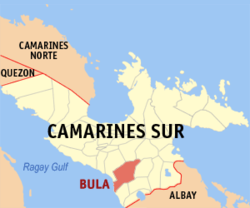Bula, Camarines Sur
| Bula | ||
|---|---|---|
| Municipality | ||
 |
||
|
||
 Map of Camarines Sur showing the location of Bula |
||
| Location within the Philippines | ||
| Coordinates: 13°28′N 123°17′E / 13.47°N 123.28°ECoordinates: 13°28′N 123°17′E / 13.47°N 123.28°E | ||
| Country | Philippines | |
| Region | Bicol (Region V) | |
| Province | Camarines Sur | |
| District | 5th district | |
| Barangays | 33 | |
| Government | ||
| • Mayor | Amelita A. Ibasco | |
| Area | ||
| • Total | 167.64 km2 (64.73 sq mi) | |
| Population (2015 census) | ||
| • Total | 69,430 | |
| • Density | 410/km2 (1,100/sq mi) | |
| Time zone | PST (UTC+8) | |
| ZIP code | 4430 | |
| IDD : area code | +63 (0)54 | |
| Income class | 2nd class; partially urban | |
| Website | www |
|
Bula, (Rinconada Bikol: Banwaān ka Bula; Tagalog: Bayan ng Bula) is a second class municipality in the province of Camarines Sur, Philippines. According to the 2015 census, it has a population of 69,430 people.
The town of Bula is historically considered as one of the first four towns of Camarines Sur founded by the Spanish conquistadores when they set foot on the Bicol soil coming from the Visayas, 1576. The other premier towns were Naga, Quipayo and Nabua.The Spaniards who came first to this place asked the men splitting bamboos and they got the answer "Bu-la". And so Bula became the name of the town.
Bula is bounded on the north by the municipalities of Pili and Ocampo, on the east by the municipality of Baao, on the southeast by the Municipality of Nabua, on the south it is bounded by the Municipality of Balataan, on the southwest by Ragay Gulf, and on the west by the Municipality of Minalabac. It approximately 25 kilometres (16 mi) southwest of Naga City.
Bula is politically subdivided into 33 barangays.
In the 2015 census, the population of Bula, Camarines Sur, was 69,430 people, with a density of 410 inhabitants per square kilometre or 1,100 inhabitants per square mile.
The Municipality of Bula is historically one of the first four mission towns of Camarines Sur founded by Spanish conquistadores in 1576. Bula was established together with Quipayo, Naga and Nabua. However, it was only in 1578 when the natives where Christianized, so the National Historical Commission dates back our history to 1578. From this historical fact, Bula, whose chosen Saint is St. Mary Magdalene celebrates its fiesta every 22nd day of July, which is the birthdate of the Saint.
Majority of the people speak the Bula-Pili variant, a lowland dialect (sinaranəw) of Rinconada Bikol language, also known as Riŋkonāda. The population can also understand and speak Tagalog or Filipino language and English.
People of Bula are divided into different Christian sects. Most of the population are Roman Catholic and Iglesia ni Cristo members which are the biggest bulk of Bulaeños adhering to Christian faith. The rest of population are followers of different Protestant denominations.
...
Wikipedia


